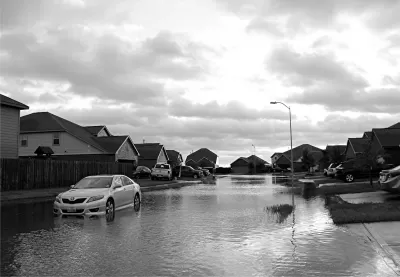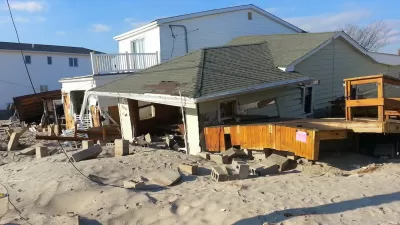With climate risks threatening more communities, providing clear, accessible risk information to potential homebuyers can help households make informed decisions and inform local resiliency efforts.

A new report from Redfin shows that making flood risk data available to homebuyers has a significant impact on their bidding behavior, with homebuyers who view flood risk data more likely to bid on lower-risk homes. Lily Katz, Daryl Fairweather and Sebastian Sandoval-Olascoaga describe the report for Redfin News.
According to the report, “Redfin users who viewed homes with an average flood-risk score of 8.5 (severe/extreme risk) prior to the study went on to bid on homes with an average score of 3.9 (moderate risk) after gaining access to flood-risk data—a decrease of 54%. By comparison, users who viewed homes with an average score of 8.5 before the study but did not get access to risk data went on to bid on homes with an average score of 8.5.” The authors note that “We only saw this impact on users who had been viewing homes with severe/extreme risk prior to the study, suggesting that flood danger is currently unlikely to change homebuyer decisionmaking unless it’s substantial.”
Notably, despite the shortage of available homes and skyrocketing prices during the study period, “flood-risk data caused Redfin users to become more selective about the homes they viewed and bid on—a sign that many homebuyers take climate risk seriously.”
While individual households can make the decision to move away from flood-prone areas, Redfin Chief Economist Daryl Fairweather says “Unfortunately, that may mean passing on the risk to someone else. Governments can help prevent that by purchasing and demolishing at-risk homes, and subsidizing climate-resilient improvements. Upgrades like landscaping, flood walls and flood openings to direct water away from homes can help an at-risk property retain value.”
FULL STORY: Homebuyers With Access to Flood-Risk Data Bid on Lower-Risk Homes

Study: Maui’s Plan to Convert Vacation Rentals to Long-Term Housing Could Cause Nearly $1 Billion Economic Loss
The plan would reduce visitor accommodation by 25,% resulting in 1,900 jobs lost.

North Texas Transit Leaders Tout Benefits of TOD for Growing Region
At a summit focused on transit-oriented development, policymakers discussed how North Texas’ expanded light rail system can serve as a tool for economic growth.

Why Should We Subsidize Public Transportation?
Many public transit agencies face financial stress due to rising costs, declining fare revenue, and declining subsidies. Transit advocates must provide a strong business case for increasing public transit funding.

How Community Science Connects People, Parks, and Biodiversity
Community science engages people of all backgrounds in documenting local biodiversity, strengthening connections to nature, and contributing to global efforts like the City Nature Challenge to build a more inclusive and resilient future.

Alabama: Trump Terminates Settlements for Black Communities Harmed By Raw Sewage
Trump deemed the landmark civil rights agreement “illegal DEI and environmental justice policy.”

Dear Tesla Driver: “It’s not You, It’s Him.”
Amidst a booming bumper sticker industry, one writer offers solace to those asking, “Does this car make me look fascist?”
Urban Design for Planners 1: Software Tools
This six-course series explores essential urban design concepts using open source software and equips planners with the tools they need to participate fully in the urban design process.
Planning for Universal Design
Learn the tools for implementing Universal Design in planning regulations.
City of Santa Clarita
Ascent Environmental
Institute for Housing and Urban Development Studies (IHS)
City of Grandview
Harvard GSD Executive Education
Toledo-Lucas County Plan Commissions
Salt Lake City
NYU Wagner Graduate School of Public Service





























